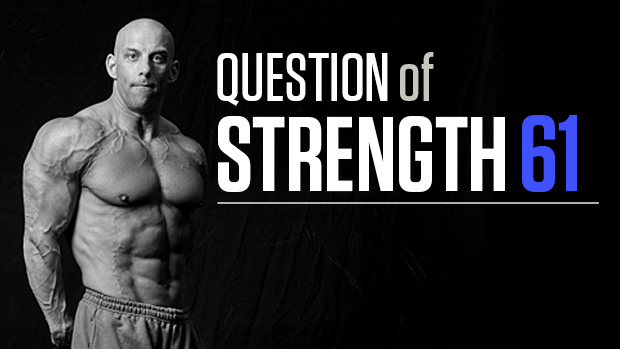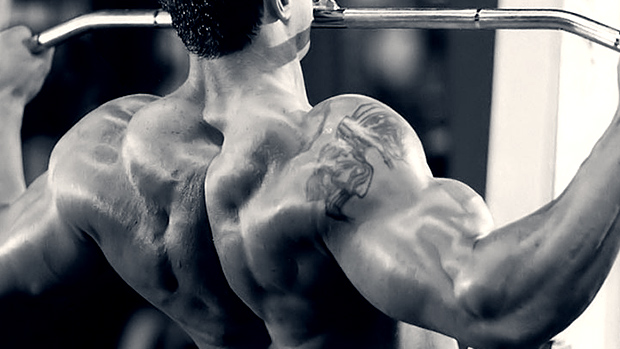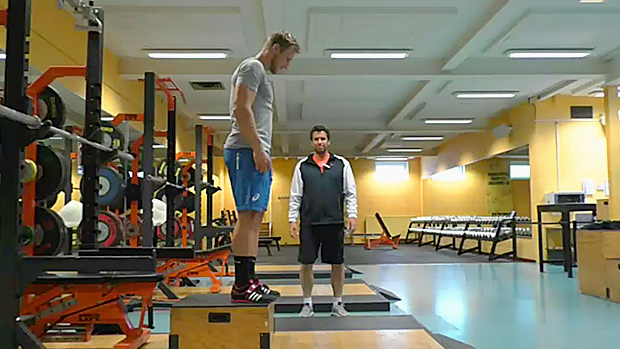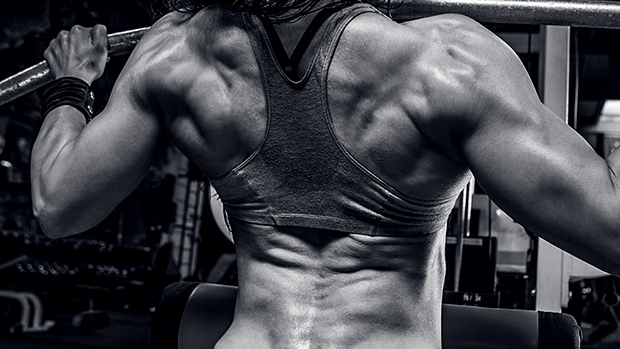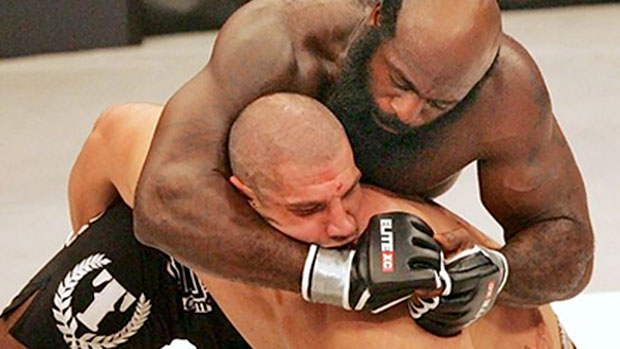How do you lose fat weight without losing muscle weight? Does time under tension (TUT) matter as much as we used to think it did? Find out here.
Question: I'm trying to get ripped and struggling to do so without losing muscle. By tracking calories and macros I'm losing about half a pound a week. My protein intake is 45% of my total calories.
But I seem to be losing equal parts muscle and fat. I've backed off on volume and train five days a week. My sessions focus on one big lift with a few accessory exercises. I've still maintained my max lifts. What can I do to halt muscle loss?
First, let's discuss the fear of losing muscle while dieting. It's a common phenomenon, but I seriously doubt you're losing muscle because:
- Your protein intake is more than sufficient for your size.
- You're only losing a conservative amount of weight, indicating that the restriction is not excessive.
- You seem to have maintained your strength.
Unless you're under 10 percent body fat, it's very unlikely that you're losing muscle if you're still training and eating sufficient protein, which would be around 1 to 1.25 grams per pound. (Yes, even in a caloric deficit.)
You might FEEL like you're losing muscle. You might look smaller or deflated, but that comes from storing less glycogen and water inside your muscles. Glycogen is how your body stores carbs inside the muscles; it's a combination of glucose (broken down carbs) and water.
If you're cutting calories (and likely carbs) you'll store less glycogen. Why? Because you don't have "extra energy" to store since you're pretty much using it all.
If you store less glycogen and water, your muscles become flatter and smaller looking. A muscle with less glycogen/water is like a balloon with less air. That can mess with your mind, but it's not muscle loss.
To build or maintain muscle you need a growth stimulus, protein for muscle repair, and energy to fuel the building process. If you're still training hard and eating sufficient protein you should at least maintain muscle.
What About Energy?
If you're in a caloric deficit don't you lack the energy to build muscle?
Not if you're over 8-9 percent body fat. Above that, your body has plenty of stored energy to fuel the process without risk of running out of stored fuel.
Once you get down to low body fat, it's possible that you'll be unable to fuel the repair process since your body might want to preserve the little energy store it has for simple things, like survival.
But until you're really lean, unless you REALLY consume an idiotic amount of calories, you shouldn't lose muscle.
Does Strength Loss Indicate Muscle Loss?
Not necessarily. It's true that a lot of people lose some strength when they diet. But it's rarely due to muscle loss. There are other reasons.
First, notice that the strength loss is mostly on multi-joint exercises. The bench press, military press, and squats are especially affected. This loss in "strength" doesn't happen on isolation or machine exercises, and often doesn't affect pulling exercises.
It's typical to maintain or even increase strength on the tricep extension, pec deck, and dumbbell lateral raise, yet see your bench press, which requires the same muscles, go down.
Clearly, this isn't due to muscle loss, otherwise the isolation exercises would go down too. In fact, oftentimes the free-weight bench press will go down but pressing on a chest machine will stay up or even increase.
The reason? A decrease in passive stability. That's when non-contractile elements stabilize a joint by increasing pressure. For example, if you blow up a muscle by storing more water, glycogen, and fat, that muscle becomes inflated and "packs" the joint more. This creates pressure which makes the joint more stable. Even body fat can contribute to passive stabilization and water retention.
Why is that important? Because if a joint is less stable, the body will protect itself by inhibiting force production (not allowing you to use all of your strength potential to avoid injuries). The more stable the body feels, the more of your strength it will allow you to use.
That's why it's common for powerlifters to "bloat up" before a meet. They'll eat a boatload of salty, high-carb food and drink tons of water to increase both glycogen and water retention. This increases passive stability and allows them to lift more weight.
Pressing movements are more affected because they're more "dangerous" for the shoulder joint, which is the least stable joint in the body.
Another Factor: Beta-Adrenergic Desensitization
Another reason you can be losing strength while dieting is due to beta-adrenergic desensitization.
The beta-adrenergic receptors are the ones that interact with adrenaline. At the muscle level, beta-receptors – when activated by adrenaline – increase muscle contraction strength and speed. At the brain and nervous system level, they'll increase coordination, drive, willpower, confidence, etc.
In other words, when your beta-adrenergic receptors respond well to adrenaline, your chance of optimal physical performance is much higher.
But if they're not responding well to adrenaline (when they're desensitized or downregulated) then strength and speed goes down. You also find yourself in a worse mental state.
Why's that relevant to dieting? You desensitize the beta-adrenergic receptors by overproducing adrenaline – either bursts that are excessive, or adrenaline levels that stay high for too long.
Adrenaline is increased in large part by cortisol. Cortisol increases the conversion of noradrenaline to adrenaline.
One of the functions of cortisol is to mobilize stored energy. When you're dieting you need to mobilize more energy, so cortisol production goes up and so does adrenaline. That's why a lot of people have a hard time sleeping when dieting.
In that regard, dieting can lead to a decrease in physical and mental performance by making you less responsive to adrenaline. When that happens, strength will go down more across the board. But it normally takes longer to occur than the strength loss from lowered passive stability.
Another reason for a loss of strength is your mental state. If you feel small and don't sleep as well it'll be much harder to get amped up to lift big weights. It's like you program yourself to believe that you're losing muscle and getting weaker – it's a self full-filling prophecy.
And your strength isn't even going down! That'd be another clear sign you're not losing muscle.
You may have had expectations about being at a certain weight when you get to the leanness level you want. This is common. But when you began approaching that weight, and didn't yet look lean, you assumed that it was because you were losing muscle along with the fat.
But the reality is that you just had more fat to lose than you thought and also carried less muscle than you assumed. Not fun to hear, but this is what happens to a lot of people.
Here's When Muscle Loss DOES Occur
Sure, you can lose muscle when dieting:
- It can happen when you're under 9-10 percent body fat, and even then it's not automatic, just more likely to occur.
- It can happen when you've been dieting for a very long time.
- It can happen if the level of caloric restriction is excessive. For example, losing more than three pounds per week after the first week.
There are factors that can make it harder to build muscle or retain it while you're in a deficit. The main ones are the higher cortisol levels and the lowered mTOR and IGF-1 levels.
The former (cortisol levels) will occur when cutting calories. That's just a fact. But cortisol can also be released due to life stress and the training session. A lot of people who actually lose muscle when dieting only do so because they're afraid of losing muscle.
What?! Yes, when you're afraid of losing muscle, you actually just might.
You may dramatically increase your training volume and "kill it" in the gym in the hopes of preventing the loss of muscle. When lifters feel flatter or more deflated because of their diets, they often do a stupid amount of volume just to try and achieve that pumped feeling.
That excessive volume will lead to excess cortisol production, which can lead to muscle loss. It can also lead to causing too much muscle damage for your body to recover from. Your capacity to repair and build muscle will be much lower if you cause too much muscle damage in that state... and then you CAN lose precious muscle tissue.
My Best Advice For Cutting
- Use an appropriate caloric intake. Aim for losing about two pounds per week after the first week. (In the first week you'll likely lose more.) At least until you're around a true 10-11 percent body fat. At that point if you want to get leaner you should shoot for around a one pound loss per week.
- Keep protein high. Shoot for a little over one gram per pound of your starting body weight. Don't lower that amount as your bodyweight goes down.
- Keep carbs around your workout. This will help decrease the cortisol response, maintain glycogen stores, and improve performance. I'd also consume sodium around the workout. Plazma™ is perfect for this because of the type of carbs and electrolyte content, which kills two birds with one stone.
- Don't be stupid with volume. It won't be as helpful as intensity. Do fewer sets but push them to the limit or close to it.
- It's all about mindset. You will feel flat and feel smaller in your clothes. And for a good number of weeks, you might not look any better because you look smaller but aren't yet lean enough to look defined. Mentally, this period is hard. Know that you're not losing muscle, and if you endure, you'll look better.
- Keep sodium high. It'll help keep you fuller-looking and get pumps.
How Big Are You Now?
There's one thing I want to mention, and it may change your decision on whether or not to proceed. Depending on how lean you are at the moment, you might need to get much smaller than you think to get truly ripped.
Let's say you lose 10 pounds and you still don't look all that lean. Your first reaction will be to think that you're losing muscle instead of fat. But in reality, you just needed to lose more fat than you expected to get to the leanness level you want.
Here's a real-life example. When I was still working with bodybuilders, a guy approached me for coaching. He wanted to do a show. He was about 5'9" and around 220 pounds. He told me he thought he could be at the bottom of the heavyweight or top of the light-heavy class – so 198 to 204 pound class. I told him that on contest day he'd be 176.
He looked like he saw a ghost. The guy wasn't fat, mind you. Just the typical bro physique. Muscular, but not defined.
Fast forward to contest day. He ended up being EXACTLY 176 pounds! He won his class and the overall.
Bottom line is, he needed to lose about 44 pounds to look as ripped as he wanted, even though he initially believed he needed to drop 22 pounds.
Based on the information you provided, you're doing everything right. You just had an erroneous perception of how much muscle you carried and how much fat you have to lose.

Question: Does time under tension (TUT) matter for hypertrophy or is that mostly bro-science?
Time under tension refers to the duration in seconds of a set. If you do 10 reps with a 3 second eccentric (lowering phase) and a 1 second concentric (lifting phase) the TUT will be roughly 40 seconds.
Now, does it matter for muscle growth? Yes and no.
My recommendation (for most people on most exercises) is just trying to get gradually stronger for sets of 6-10 reps while controlling the eccentric and maintaining tension. This is the best way to stimulate growth.
But let's take a closer look at TUT. It's not a primary factor involved in growth, and the set duration itself isn't really important. But the physiological response to a certain duration of TUT may play a role in growth.
Did you get that? The TUT itself and the physiological response (lactate and growth factor accumulation during a set lasting 40-60 seconds) are not what I'd call a growth stimulus. But they can increase the adaptation from the stimulus.
So, what's the main stimulus for growth? If we were to use an equation it would look something like this:
(Muscle fiber recruitment + Mechanical loading of these fibers) X number of reps = hypertrophy stimulus
The number of muscle fibers you recruited is dependent on the amount of force required relative to your maximum force production potential during that rep. You can increase the amount of force required relative to your maximum a few different ways:
- Use heavier weights. Heavier weights = greater percentage of your maximum.
- Create fatigue. Do more reps or use supersets, which decreases your relative maximum from rep to rep because the muscle is tired.
- Accelerate as much as possible when lifting the weight (force = mass x acceleration). But you'll see why this is good for strength and power, but not optimal for hypertrophy.
Mechanical loading refers to imposing a mechanical stress on the muscle fibers. That means you must create as much muscle tension as possible to stretch the muscle fibers while tension is still there.
Tension is related to the amount of force the muscle needs to produce. The more force required, the higher the tension will be.
Let's look at how muscles contract. Each muscle fiber has actin and myosin filaments. They connect with each other when the myosin heads hook themselves to the actin. This is called a "cross-bridge."
Then, the myosin heads pull the actin, shortening the muscle. It looks like this:



Now understand that the more force/tension you need to produce, the more bridges you'll form.
During the eccentric phase of an exercise, when the muscle's fibers are lengthening (being stretched), if the bridges remain connected you create muscle damage and stimulate mTOR activation – the two most important hypertrophy stimuli.


The bridges can only shorten the muscle fiber, they can't lengthen it.
If the bridges remain connected, muscle tension is high, and you perform an eccentric action, the load is lengthening the fibers while the bridges are trying to shorten them. This is mechanical stress and it's the main trigger for growth.
That's why if you have zero control of the weight during the eccentric (very low tension), it's much less effective for growth because when you don't actively resist the weight, muscle tension goes down, the number of bridges goes down, and the potential for muscle damage and mTOR activation is lower.
To maximize the mechanical stress you must:
- Create as many actin-myosin cross-bridges as possible, which is how muscle contracts. The more force you need to produce, the more of those bridges you create.
- Keep tension fairly constant during the rep. That's why too much acceleration can decrease mechanical loading. When you produce too much momentum, you need less force from the muscle to lift the weight, so you decrease the number of bridges formed.
- Lengthen/stretch the fibers while the tension remains high. Less tension means less actin-myosin cross-bridges, which means less hypertrophy stimulation. That's why it's more effective to do the eccentric under control, not fast. The stretching of the fibers while they're producing tension is responsible for muscle damage and mTOR activation.
Recruit as many fibers as you can, create a lot of bridges in those fibers, and lengthen the fibers while as many bridges as possible are formed. Do that over several reps. That's it!
What About TUT?
That's why the number of reps is more important than the time under tension. With every rep you do, you have a new bout of mechanical stress via a new loaded lengthening of the muscle fibers.
Here are two hypothetical scenarios to illustrate my point:
>
- A. 10 reps with 225 pounds and a 2010 tempo (2 seconds to lower, no pause at the bottom, 1 second to lift, no pause at the top). That's a TUT of 30 seconds because each rep took 2 seconds to lower.
- B. 5 reps with 225 pounds and a 5010 tempo. That's still a TUT of 30 seconds because each rep took 5 seconds to lower... but you did fewer total reps.
Even if the load and TUT are the same, scenario A is more effective.
Why? Because the number of times you stretch a muscle fiber in a set has an important impact on muscle damage and mTOR activation. Think of it like this: every time you get to stretch a fiber under load, you trigger growth.
Now if you add a third scenario where you're doing 10 reps with a 5010 tempo (a TUT of 60 seconds) would it be more effective? Nope!
To do that you'd have to use significantly less weight, probably something like 185-195 pounds instead of 225 pounds. The lower weight would lead to less muscle tension and each rep would be less effective.
Caveat: In that example, the longer time under tension will have some benefits that can increase muscle growth though. When you reach the 40-60 second range, if the intensity is high enough so that you reach failure in that time zone, you'll be producing a lot of lactate and growth factors, which can help with the adaptation to training.
The three scenarios in order of effectiveness would be:
- 10 reps at 225 pounds with a 2010 tempo
- 10 reps at 195 pounds with a 5010 tempo
- 5 reps at 225 pounds with a 5010 tempo
By completely decreasing tension during the eccentric and lifting explosively, you minimize mTOR and even muscle damage. This would be great for strength and power, but not great for hypertrophy.
The new order would be:
- 10 reps at 225 pounds with a 2010 tempo
- 10 reps at 195 pounds with a 5010 tempo
- 5 reps at 225 pounds with a 2010 tempo
Does TUT Matter Or What?
It will never be the main growth stimulus. All it does is lead to certain physiological responses, like lactate and growth factor production, which can play a small role in hypertrophy.
Local growth factors can help stimulate protein synthesis slightly (which speeds up muscle tissue repair and building) while lactate can increase follistatin levels which can inhibit myostatin a bit.
Lower myostatin leads to the possibility of building more muscle. But don't jump on the lactate bandwagon just yet – it likely won't make a huge difference.
I do like to shoot for longer TUT on exercises that won't cause much muscle damage. Think isolation work mainly... especially if the eccentric isn't loaded for the whole range like lateral raises and barbell curls. This would be a good approach with people who have a harder time repairing muscle damage, like older individuals or people with a very high stress level.
For these cases, shooting for a TUT of 40-60 seconds with a moderate weight can be beneficial.
By the way, I use a lot of slow eccentrics. I'm not being contradictory: I use them for other reasons than stimulating maximum growth, like improving motor learning, strengthening tendons and becoming stronger eccentrically.

